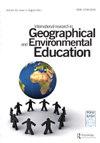从规模上考虑地理和环境教育
IF 3.1
Q2 EDUCATION & EDUCATIONAL RESEARCH
International Research in Geographical and Environmental Education
Pub Date : 2021-04-03
DOI:10.1080/10382046.2021.1912969
引用次数: 3
摘要
回想一下你第一次使用谷歌地球的情景。大多数人通常会在应用程序上输入自己的地址,并通过现实的数字表示找到自己的居住地。通常情况下,有人会将住宅的视野缩小到附近,然后缩小到城镇、城市甚至乡村的视野,然后再缩小到地球是一个球体,或者屏幕上球体的二维表示。在地理空间技术的早期,像这样的应用程序使我们能够轻松地跨空间尺度检查我们的居住地。教育工作者也很快利用这种启示来设计课程,要求学生在空间尺度上研究地理或环境问题。地理学家和地理教育工作者也经常使用尺度作为分析框架,这不仅仅是偶然的。规模是一个如此强大的组织和分析概念,用于研究地理和环境现象,这是有充分理由的。我们建议,量表在地理和环境教育中的作用可以通过它作为地理思维的一个实质性概念以及教育问题的分析框架来讨论。地理教育经常使用的一个关键概念是规模。虽然空间、地点和人与环境互动的概念更明显地被用作地理学中标志性概念的例子,但规模的概念为地理学家提供了一种跨越其他概念的方法,并为组织地理教育中复杂现象的讨论提供了一个模式。在讨论地理对教育的贡献时,《2016年国际地理教育宪章》(Stoltman,Lidstone,&Kidman,2017),或者简称《宪章》,这些贡献也是通过空间尺度组织的。从考虑个人的“好奇心”到理解与其他物种的“关系”,再到理解“地方”和“景观”,再加上生活在一个“紧密相连的世界”意味着什么,从地方到全球范围都对各种贡献进行了解释(IGU-CGE,2016,第5页)。事实上,自然现象和人为现象都通过不同的空间尺度对人类产生影响。为了清楚起见,当将尺度作为一个地理概念时,我们将使用“空间尺度”一词。规模不仅仅局限于我们定义空间或地点的方式。Chang和Wi(2018)认为,像本地和全球这样的规模术语不仅仅是地点,而是过程,因为“全球化和本地化产生了不同的空间背景,是分化和整合的混合体”(Chang&Wi,2018,29)-不同的背景和更大整体的一部分。规模作为一个组织概念,使我们能够以另一种方式来考察地理现象的背景和条件,而不是通过视角或立场。为了清楚起见,我们将把这种规模的概念称为过程规模。利用差异化和整合的概念,教育问题也可以通过这种规模概念来组织。例如,在个人层面,我们本文章由计算机程序翻译,如有差异,请以英文原文为准。
Considering geographical and environmental education at scales
Recall the first time you used Google Earth. Most people would typically key in their address and find where they lived on a digital representation of reality on the application. It was not uncommon for someone to then zoom out of the view of their residence to the neighbourhood, and then the town, city or even country views before zooming out to see the earth as a sphere, or a two dimensional representation of the sphere on the screen. During the early days of geospatial technologies, an application like this allowed us to examine where we live across spatial scales easily. Educators were also quick to use this affordance to design lessons requiring students to examine geographical or environmental issues across spatial scales. It is not just serendipitous that geographers and geography educators also often employ scale as a framework for analysis. There is a good reason why scale is such a powerful organising and analysing concept for examining geographical and environmental phenomena. We propose that the role of scales in geographical and environmental education can be discussed through it as a substantive concept for geographical thinking, as well as a frame of analysis for issues in education. One of the key concepts that geographical education often utilises is scale. While concepts of space, place and human-environment interaction are more obviously used as examples of the signature concepts in geography, the concept of scale provides geographers with an approach that cuts across the other concepts and offers a schema for organising discussion about complex phenomena within geographical education. In discussing the contribution of Geography to education, the 2016 International Charter on Geographical Education (Stoltman, Lidstone, & Kidman, 2017), or the Charter in short, these contributions were also organised through spatial scales. From considering individual “curiosity” to understanding “relationship” to other species, to understanding “places” and “landscapes”, to what it means to live in a “tightly interconnected world”, the various contributions are explained from the local to the global scales (IGU-CGE, 2016, p. 5). Indeed, phenomena that are both natural and man-made have implications for humankind through different spatial scales. For the purpose of clarity, when referring to scale as a geographical concept, we will utilise the term spatial scale. Scale is not just limited to the way we define space or place. Chang and Wi (2018) argue that terms referring to scale like local and global are not just locations but processes in that “globalisation and localisation produce different spatial contexts that are hybrids ... of both differentiation and integration” (Chang & Wi, 2018, p. 29) – contexts that are different and contexts that are part of a larger whole. Scale as an organising concept allows us another way to examine the contexts and conditions to a geographical phenomenon other than through perspectives or standpoints, for example. For clarity, we will refer to this notion of scale as process scale. Using the notion of differentiation and integration, educational issues can also be organised across this notion of scales. For example, at the individual level, we are
求助全文
通过发布文献求助,成功后即可免费获取论文全文。
去求助
来源期刊

International Research in Geographical and Environmental Education
EDUCATION & EDUCATIONAL RESEARCH-
CiteScore
5.20
自引率
33.30%
发文量
11
期刊介绍:
International Research in Geographical & Environmental Education publishes quality research studies within the context of geographical and environmental education. The journal endeavours to promote international interest and dissemination of research in the field, provides a forum for critique, and demonstrates the relevance of research studies to good professional practice.
 求助内容:
求助内容: 应助结果提醒方式:
应助结果提醒方式:


